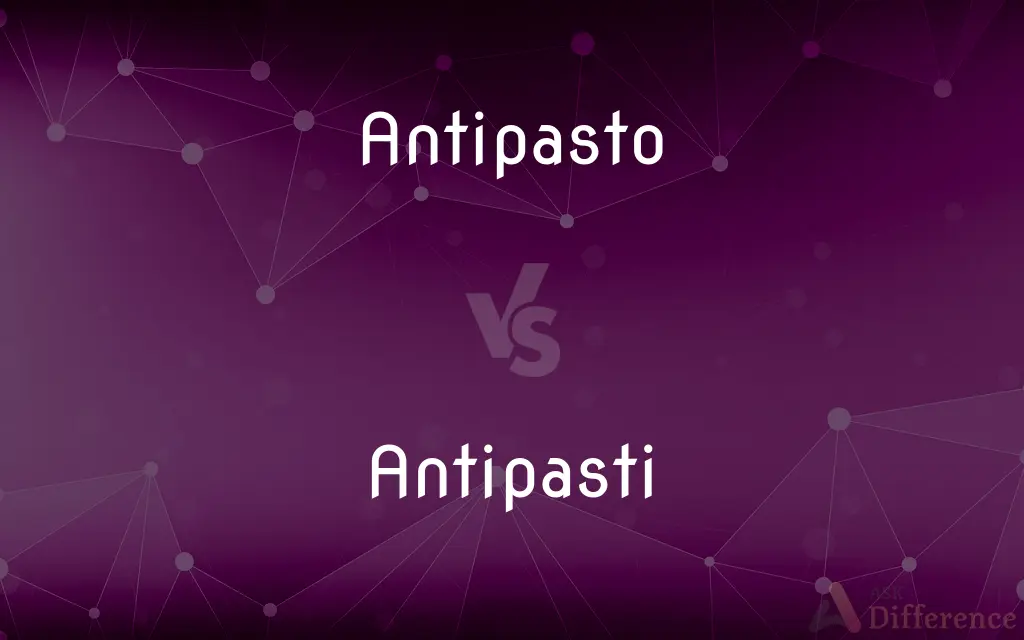Antipasto vs. Antipasti — What's the Difference?
Edited by Tayyaba Rehman — By Maham Liaqat — Updated on February 29, 2024
Antipasto is the singular form, referring to a traditional Italian appetizer, while antipasti are the plural form, indicating multiple appetizer dishes.

Difference Between Antipasto and Antipasti
Table of Contents
ADVERTISEMENT
Key Differences
Antipasto, in Italian cuisine, is the appetizer or starter course, traditionally served before the main meal. It consists of a variety of ingredients, such as cured meats, cheeses, olives, and vegetables, aimed at stimulating the appetite. The singular term "antipasto" can refer to a single type of such appetizer or collectively to a platter of mixed items served as the first course.
Antipasti, the plural form of antipasto, encompasses a wider array of these starter dishes, often presented together during a meal. When referring to antipasti, it implies a selection or assortment of various antipasto dishes, allowing diners to enjoy a diverse range of flavors and textures. This distinction is important in Italian dining, where meals are structured into multiple courses, and the antipasti phase is an integral part of the experience.
"Antipasto" might be used to describe the concept of starters in general or a specific dish, "antipasti" specifically highlights the variety and abundance of choices available. This can include anything from marinated vegetables to slices of prosciutto, offering a glimpse into the regional specialties and culinary craftsmanship of Italy.
The terms are often used interchangeably outside of Italy, but understanding the distinction can enhance the dining experience, reflecting the richness of Italian culinary traditions. Whether one is served a single antipasto dish or an assortment of antipasti, these appetizers set the tone for the meal, reflecting the Italian emphasis on fresh ingredients, vibrant flavors, and communal dining.
The choice between antipasto and antipasti can also signal the scale of the meal to come, with a lavish spread of antipasti often preceding more elaborate or special occasion meals. Thus, these terms do more than categorize the course; they hint at the culinary journey ahead, inviting diners to savor each bite as a prelude to the feast that follows.
ADVERTISEMENT
Comparison Chart
Definition
A single appetizer or starter dish
Multiple appetizer dishes
Usage
Singular
Plural
Composition
Can include cured meats, cheeses, olives, vegetables
A variety of such dishes, showcasing a range of flavors
Context
Served as the first course of an Italian meal
Indicates a selection of starters
Culinary Role
Stimulates the appetite for the main courses
Offers a diverse tasting experience before the main meal
Compare with Definitions
Antipasto
Designed to stimulate appetite.
The chef prepared a light antipasto to begin the meal.
Antipasti
Encompasses diverse flavors.
Antipasti included everything from marinated artichokes to caprese salad.
Antipasto
A traditional Italian starter.
For antipasto, they served a plate of olives and cured meats.
Antipasti
Offers communal dining experience.
They shared a platter of antipasti, enjoying the communal aspect of the meal.
Antipasto
Reflects regional flavors.
The antipasto featured local specialties, highlighting regional cuisine.
Antipasti
Plural of antipasto, indicating a variety of dishes.
The table was adorned with a lavish spread of antipasti.
Antipasto
Served before the main course.
Antipasto was served as a prelude to a sumptuous Italian feast.
Antipasti
Sets the stage for the meal.
A selection of antipasti was presented to guests as an introduction to the dinner.
Antipasto
Often a mixed platter.
The antipasto included an assortment of Italian cheeses and bruschetta.
Antipasti
Reflects culinary tradition.
The antipasti served were a testament to the rich culinary heritage of Italy.
Antipasto
Antipasto (plural antipasti) is the traditional first course of a formal Italian meal. Typical ingredients of a traditional antipasto include cured meats, olives, peperoncini, mushrooms, anchovies, artichoke hearts, various cheeses (such as provolone or mozzarella), pickled meats, and vegetables in oil or vinegar.
Antipasti
An appetizer usually consisting of an assortment of foods, such as smoked meats, cheese, fish, and vegetables.
Antipasto
An appetizer usually consisting of an assortment of foods, such as smoked meats, cheese, fish, and vegetables.
Antipasto
An Italian starter for a meal; normally a cold assortment of salami, cheese, seafood and vegetables.
Antipasto
A course of appetizers in an Italian meal
Common Curiosities
How do you choose antipasti for a meal?
Selections are often based on regional specialties, seasonal ingredients, and the balance of flavors to complement the subsequent courses.
Is there a vegetarian antipasto option?
Yes, vegetarian antipasto can include a variety of marinated vegetables, cheeses, and bread-based dishes like bruschetta.
What distinguishes antipasto from other appetizers?
Antipasto is specifically Italian and characterized by its ingredients and role in the meal structure, aiming to stimulate the appetite.
How important is presentation in serving antipasto?
Presentation is key, as antipasto is not just about taste but also about creating a visually appealing and inviting start to the meal.
Can antipasto be adapted for different dietary restrictions?
Yes, antipasto can be easily adapted to accommodate dietary needs, including gluten-free, dairy-free, and vegan options.
Can antipasto be a meal on its own?
While traditionally a starter, a generous antipasto platter can serve as a light meal, especially in a casual or social setting.
How are antipasto and antipasti served?
They can be served on individual plates, as a shared platter, or buffet-style, depending on the dining context.
What is the significance of antipasto in Italian dining?
Antipasto marks the beginning of the meal, setting the tone and pace for the dining experience, reflecting Italian hospitality and culinary culture.
How has the concept of antipasto evolved in modern cuisine?
While retaining traditional elements, modern antipasto may incorporate innovative ingredients and presentation styles, reflecting contemporary culinary trends.
Is there a difference in antipasto selection between Northern and Southern Italy?
Yes, regional variations reflect local ingredients and culinary traditions, with Northern Italy favoring meats and cheeses, while Southern Italy features more seafood and vegetables.
What is typically included in antipasto?
Antipasto may include cured meats, cheeses, olives, marinated vegetables, and seafood.
Can antipasto include sweet elements?
Typically, antipasto focuses on savory flavors, but sweet elements like fruit may appear, especially in combination with cheeses.
Can antipasto influence the choice of main courses?
Yes, the selection of antipasto can complement and influence the flavors of the main courses, creating a cohesive dining experience.
How do you pronounce antipasto and antipasti?
Antipasto is pronounced "an-tee-PAH-sto," while antipasti is pronounced "an-tee-PAH-stee."
What is the best wine to pair with antipasto?
The pairing depends on the ingredients of the antipasto; light white wines or sparkling wines are often a good match for a variety of flavors.
Share Your Discovery

Previous Comparison
Slice vs. Chop
Next Comparison
Chinches vs. BedbugAuthor Spotlight
Written by
Maham LiaqatEdited by
Tayyaba RehmanTayyaba Rehman is a distinguished writer, currently serving as a primary contributor to askdifference.com. As a researcher in semantics and etymology, Tayyaba's passion for the complexity of languages and their distinctions has found a perfect home on the platform. Tayyaba delves into the intricacies of language, distinguishing between commonly confused words and phrases, thereby providing clarity for readers worldwide.















































